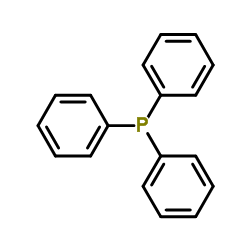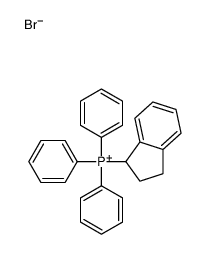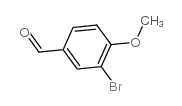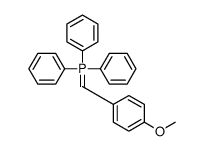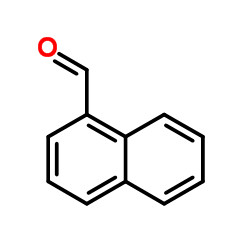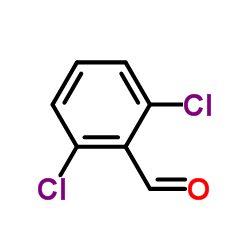6399-81-1
| 中文名 | 三苯基膦氢溴酸盐 |
|---|---|
| 英文名 | Triphenylphosphine hydrobromide |
| 中文别名 | 三苯基溴化鏻 |
| 英文别名 |
MFCD00035107
phosphine, triphenyl-, hydrobromide EINECS 229-012-6 triphenylphosphane,hydrobromide Triphenylphosphine hydrobromide (1:1) Phosphine, triphenyl-, hydrobromide (1:1) |
| 沸点 | 360ºC at 760 mmHg |
|---|---|
| 熔点 | 196 °C (dec.)(lit.) |
| 分子式 | C18H16BrP |
| 分子量 | 343.197 |
| 闪点 | 181.7ºC |
| 精确质量 | 342.017303 |
| PSA | 13.59000 |
| LogP | 4.40290 |
| 外观性状 | 白色粉末 |
| 储存条件 | 避光,阴凉干燥处,密封保存 |
| 稳定性 | 常温常压下稳定,白色晶体状粉末 |
| 计算化学 | 1.疏水参数计算参考值(XlogP):无 2.氢键供体数量:0 3.氢键受体数量:0 4.可旋转化学键数量:3 5.互变异构体数量:无 6.拓扑分子极性表面积0 7.重原子数量:20 8.表面电荷:0 9.复杂度:202 10.同位素原子数量:0 11.确定原子立构中心数量:0 12.不确定原子立构中心数量:0 13.确定化学键立构中心数量:0 14.不确定化学键立构中心数量:0 15.共价键单元数量:2 |
| 更多 | 1. 性状:白色晶体状粉末 2. 密度(g/mL, 25 ℃ ):未确定 3. 相对蒸汽密度(g/mL,空气=1):未确定 4. 熔点(ºC):196-199 5. 沸点(ºC,常压):未确定 6. 沸点(ºC,1mmHg):未确定 7. 折射率:未确定 8. 闪点(ºC):未确定 9. 比旋光度(º):未确定 10. 自燃点或引燃温度(ºC):未确定 11. 蒸气压(20ºC):未确定 12. 饱和蒸气压(kPa,60ºC):未确定 13. 燃烧热(KJ/mol):未确定 14. 临界温度(ºC):未确定 15. 临界压力(KPa):未确定 16. 油水(辛醇/水)分配系数的对数值:未确定 17. 爆炸上限(%,V/V):未确定 18. 爆炸下限(%,V/V):未确定 19. 溶解性:未确定 |
Synonym:None Known Section 2 - COMPOSITION, INFORMATION ON INGREDIENTS
Risk Phrases: 36/37/38 Section 3 - HAZARDS IDENTIFICATION EMERGENCY OVERVIEW
Irritating to eyes, respiratory system and skin.Corrosive. Potential Health Effects Eye: Causes eye burns. May cause chemical conjunctivitis and corneal damage. Skin: Causes skin burns. May cause skin rash (in milder cases), and cold and clammy skin with cyanosis or pale color. Ingestion: May cause severe and permanent damage to the digestive tract. Causes gastrointestinal tract burns. May cause perforation of the digestive tract. May cause cardiac disturbances. May cause central nervous system depression. May cause systemic effects. Inhalation: Causes chemical burns to the respiratory tract. Aspiration may lead to pulmonary edema. May cause cardiac abnormalities. May cause systemic effects. Inhalation at high concentrations may cause CNS depression and asphixiation. Chronic: Effects may be delayed. Section 4 - FIRST AID MEASURES Eyes: Get medical aid immediately. Do NOT allow victim to rub eyes or keep eyes closed. Extensive irrigation with water is required (at least 30 minutes). Skin: Get medical aid immediately. Immediately flush skin with plenty of water for at least 15 minutes while removing contaminated clothing and shoes. Wash clothing before reuse. Destroy contaminated shoes. Ingestion: Never give anything by mouth to an unconscious person. Get medical aid immediately. Do NOT induce vomiting. If conscious and alert, rinse mouth and drink 2-4 cupfuls of milk or water. Inhalation: Get medical aid immediately. Remove from exposure and move to fresh air immediately. If breathing is difficult, give oxygen. Do NOT use mouth-to-mouth resuscitation. If breathing has ceased apply artificial respiration using oxygen and a suitable mechanical device such as a bag and a mask. Notes to Physician: Section 5 - FIRE FIGHTING MEASURES General Information: As in any fire, wear a self-contained breathing apparatus in pressure-demand, MSHA/NIOSH (approved or equivalent), and full protective gear. During a fire, irritating and highly toxic gases may be generated by thermal decomposition or combustion. Contact with metals may evolve flammable hydrogen gas. Containers may explode when heated. Non-combustible, substance itself does not burn but may decompose upon heating to produce irritating, corrosive and/or toxic fumes. Runoff from fire control or dilution water may cause pollution. Extinguishing Media: Use water spray to cool fire-exposed containers. Substance is noncombustible; use agent most appropriate to extinguish surrounding fire. Do NOT get water inside containers. Section 6 - ACCIDENTAL RELEASE MEASURES General Information: Use proper personal protective equipment as indicated in Section 8. Spills/Leaks: Vacuum or sweep up material and place into a suitable disposal container. Clean up spills immediately, observing precautions in the Protective Equipment section. Avoid generating dusty conditions. Provide ventilation. Section 7 - HANDLING and STORAGE Handling: Use only in a well-ventilated area. Minimize dust generation and accumulation. Do not breathe dust, vapor, mist, or gas. Do not get in eyes, on skin, or on clothing. Keep container tightly closed. Do not ingest or inhale. Discard contaminated shoes. Storage: Keep container closed when not in use. Store in a cool, dry area away from incompatible substances. Section 8 - EXPOSURE CONTROLS, PERSONAL PROTECTION Engineering Controls: Facilities storing or utilizing this material should be equipped with an eyewash facility and a safety shower. Use adequate ventilation to keep airborne concentrations low. Exposure Limits CAS# 6399-81-1: Personal Protective Equipment Eyes: Wear appropriate protective eyeglasses or chemical safety goggles as described by OSHA's eye and face protection regulations in 29 CFR 1910.133 or European Standard EN166. Skin: Wear appropriate protective gloves and clothing to prevent skin exposure. Clothing: Wear appropriate protective clothing to prevent skin exposure. Respirators: Follow the OSHA respirator regulations found in 29 CFR 1910.134 or European Standard EN 149. Use a NIOSH/MSHA or European Standard EN 149 approved respirator if exposure limits are exceeded or if irritation or other symptoms are experienced. Section 9 - PHYSICAL AND CHEMICAL PROPERTIES Physical State: Powder Color: white Odor: None reported. pH: Not available. Vapor Pressure: Not available. Viscosity: Not available. Boiling Point: Not available. Freezing/Melting Point: 196.00 - 199.00 deg C Autoignition Temperature: Not applicable. Flash Point: Not applicable. Explosion Limits, lower: Not available. Explosion Limits, upper: Not available. Decomposition Temperature: Solubility in water: Specific Gravity/Density: Molecular Formula: C18H16BrP Molecular Weight: 343.20 Section 10 - STABILITY AND REACTIVITY Chemical Stability: Stable under normal temperatures and pressures. Conditions to Avoid: Incompatible materials, dust generation, excess heat, strong oxidants. Incompatibilities with Other Materials: Oxidizing agents. Hazardous Decomposition Products: Carbon monoxide, oxides of phosphorus, irritating and toxic fumes and gases, carbon dioxide. Hazardous Polymerization: Has not been reported. Section 11 - TOXICOLOGICAL INFORMATION RTECS#: CAS# 6399-81-1 unlisted. LD50/LC50: Not available. Carcinogenicity: Triphenylphosphonium Bromide - Not listed by ACGIH, IARC, or NTP. Section 12 - ECOLOGICAL INFORMATION Section 13 - DISPOSAL CONSIDERATIONS Dispose of in a manner consistent with federal, state, and local regulations. Section 14 - TRANSPORT INFORMATION IATA Shipping Name: CORROSIVE SOLID, N.O.S.* Hazard Class: 8 UN Number: 1759 Packing Group: II IMO Shipping Name: CORROSIVE SOLID, N.O.S. Hazard Class: 8 UN Number: 1759 Packing Group: II RID/ADR Shipping Name: CORROSIVE SOLID, N.O.S. Hazard Class: 8 UN Number: 1759 Packing group: II Section 15 - REGULATORY INFORMATION European/International Regulations European Labeling in Accordance with EC Directives Hazard Symbols: XI Risk Phrases: R 36/37/38 Irritating to eyes, respiratory system and skin. Safety Phrases: S 24/25 Avoid contact with skin and eyes. WGK (Water Danger/Protection) CAS# 6399-81-1: No information available. Canada None of the chemicals in this product are listed on the DSL/NDSL list. CAS# 6399-81-1 is not listed on Canada's Ingredient Disclosure List. US FEDERAL TSCA CAS# 6399-81-1 is not listed on the TSCA inventory. It is for research and development use only. SECTION 16 - ADDITIONAL INFORMATION N/A |
|
毒理学数据: 主要的刺激性影响: 在皮肤上面:刺激皮肤和粘膜 在眼睛上面:刺激的影响 致敏作用:没有已知的敏化现象 生态学数据: 对水少是稍微危害的,不要让未稀释或大量的产品接触地下水、水道或污水系统 若无政府许可,勿将材料排入周围环境.
|
| 符号 |


GHS05, GHS07 |
|---|---|
| 信号词 | Danger |
| 危害声明 | H302-H314 |
| 警示性声明 | P280-P305 + P351 + P338-P310 |
| 个人防护装备 | Eyeshields;Faceshields;full-face particle respirator type N100 (US);Gloves;respirator cartridge type N100 (US);type P1 (EN143) respirator filter;type P3 (EN 143) respirator cartridges |
| 危害码 (欧洲) | C:Corrosive; |
| 风险声明 (欧洲) | R34 |
| 安全声明 (欧洲) | S26-S36/37/39-S45 |
| 危险品运输编码 | UN 3261 8/PG 3 |
| WGK德国 | 3 |
| 包装等级 | III |
| 危险类别 | 6.1 |
| 海关编码 | 29310095 |
|
~96% 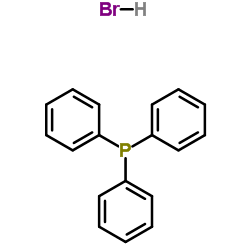
6399-81-1 |
| 文献:Aoyagi, Naoto; Furusho, Yoshio; Endo, Takeshi Tetrahedron Letters, 2013 , vol. 54, # 51 p. 7031 - 7034 |
|
~% 
6399-81-1 |
| 文献:Synthesis, , vol. 1, # 5 p. 479 - 482 |
|
~% 
6399-81-1 |
| 文献:Bulletin of the Chemical Society of Japan, , vol. 80, # 9 p. 1785 - 1790 |
|
~% 
6399-81-1 |
| 文献:Bulletin of the Chemical Society of Japan, , vol. 80, # 9 p. 1785 - 1790 |
| 上游产品 4 | |
|---|---|
| 下游产品 9 | |
| 海关编码 | 2902909090 |
|---|---|
| 中文概述 | 2902909090. 其他芳香烃. 增值税率:17.0%. 退税率:9.0%. 监管条件:无. 最惠国关税:2.0%. 普通关税:30.0% |
| 申报要素 | 品名, 成分含量 |
| Summary | 2902909090 other aromatic hydrocarbons。Supervision conditions:None。VAT:17.0%。Tax rebate rate:9.0%。MFN tariff:2.0%。General tariff:30.0% |


